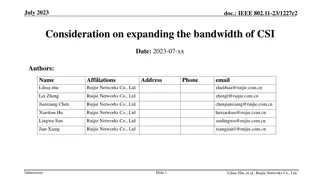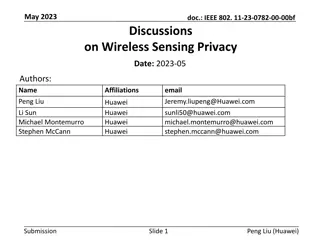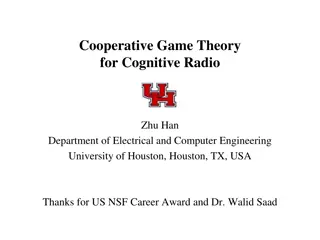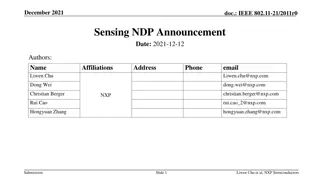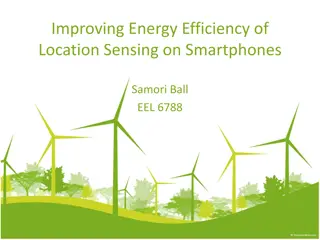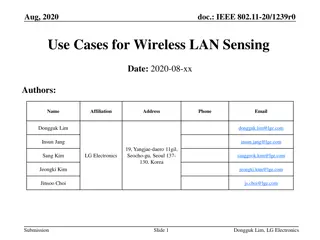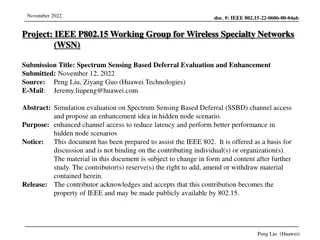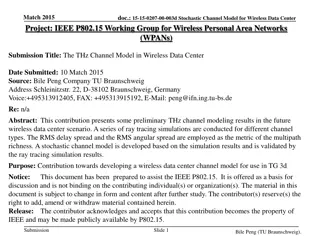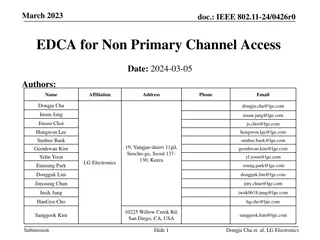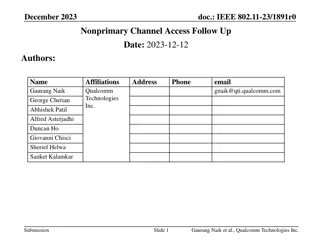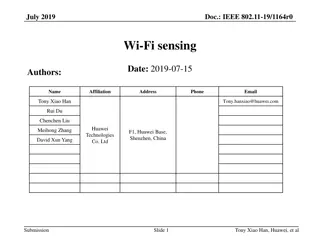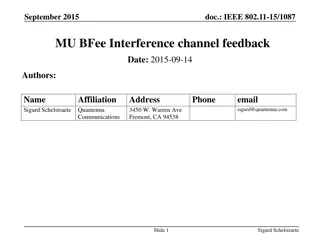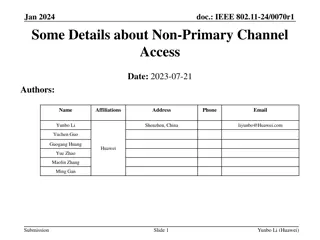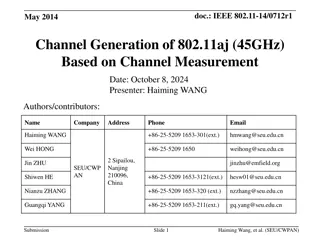Spectrum Sensing for Enhanced Channel Access in Wireless Networks
This document presents a proposal for Spectrum Sensing Based Deferral (SSBD) to improve channel access in wireless networks. SSBD incorporates spectrum sensing with transmission deferral in a time-bound manner to enhance performance, reliability, and latency control. The proposed solution safeguards high throughput data usage while avoiding disruptions to low duty-cycle ranging scenarios. By utilizing channel sensing and collision reduction techniques, SSBD aims to enhance coexistence among various spectrum users. The features include reduced airtime through collision avoidance, interference mitigation, improved link budget, support for additional channels, and operating frequencies. Furthermore, SSBD supports backward compatibility, reduces complexity, power consumption, and offers improved reliability. The document highlights the benefits of SSBD, including lower latency, higher data-rate streaming, and improved support for different communication protocols.
Download Presentation

Please find below an Image/Link to download the presentation.
The content on the website is provided AS IS for your information and personal use only. It may not be sold, licensed, or shared on other websites without obtaining consent from the author. Download presentation by click this link. If you encounter any issues during the download, it is possible that the publisher has removed the file from their server.
E N D
Presentation Transcript
March 2023 doc. #: IEEE 802.15-22-0485-01-04ab Project: IEEE P802.15 Working Group for Wireless Specialty Networks (WSN) Submission Title: Spectrum Sensing Based Deferral Submitted: March 15, 2023 Source: Benjamin Rolfe (Blind Creek Associates), Dries Neirynck (Ultra Radio Ltd), Frederic Nabki, Larry Zakaib (Spark), Frank Leong (NXP), Peng Liu, Ziyang Guo, Lei Huang, David Xun Yang (Huawei) Contact: E-Mail: ben.rolfe@ieee.org Voice: NA Re: Enhanced channel access for UWB Abstract: A variation on channel access that includes spectrum sensing and potentially deferring transmission in a time-bounded way to improve performance, reliability and bound latency Purpose: Consideration for inclusion in the draft amendment Notice: This document has been prepared to assist the IEEE 802. It is offered as a basis for discussion and is not binding on the contributing individual(s) or organization(s). The material in this document is subject to change in form and content after further study. The contributor(s) reserve(s) the right to add, amend or withdraw material contained herein. Release: The contributor acknowledges and accepts that this contribution becomes the property of IEEE and may be made publicly available by 802.15. Rolfe, et al (multiple)
March 2023 doc. #: IEEE 802.15-22-0485-01-04ab Spectrum Sensing Based Deferral Summary of SSBD proposal Rolfe, et al (multiple)
March 2023 doc. #: IEEE 802.15-22-0485-01-04ab PAR Objective Proposed Solution (how addressed) Safeguards so that the high throughput data use cases will not cause significant disruption to low duty-cycle ranging use cases SSBD uses channel sensing (CCA) with time bounded deferral to reduce collisions and mitigate hidden node scenarios Linear increase of contention window when CCA detects channel not clear or when collisions occur Can improve coexistence in the presence of UWB and non- UWB spectrum users through Energy Detection Has no impact on backward compatibility. It is an optional feature in 4ab capable devices. Reduces airtime through collision avoidance Interference mitigation techniques to support higher density and higher traffic use cases Other coexistence improvement Backward compatibility with enhanced ranging capable devices (ERDEVs) Improved link budget and/or reduced air-time Additional channels and operating frequencies Improvements to accuracy / precision / reliability and interoperability for high-integrity ranging Reduced complexity and power consumption Reliability can be enhanced by CCA based deferral of transmission Hybrid operation with narrowband signaling to assist UWB Enhanced native discovery and connection setup mechanisms Sensing capabilities to support presence detection and environment mapping Low-power low-latency streaming Reduced latency via linear backoff and collision reduction Higher data-rate streaming allowing at least 50 Mbit/s of throughput Support for peer-to-peer, peer-to-multi-peer, and station-to- infrastructure protocols Infrastructure synchronization mechanisms Yes Slide 3 Rolfe, et al (multiple)
March 2023 doc. #: IEEE 802.15-22-0485-01-04ab SSBD Overview SSBD is a channel access method for applications that use the UWB PHY SSBD enables channel access latency to be bounded Employs channel sensing using CCA and bounded deferral using linearly growing random backoff at each deferral. For unscheduled random access or with one of the scheduled access schemes. SSBD attributes settings for various use cases. SSBD is an optional feature for all 4ab device types. Optional persistence mechanism Employs persistence to mitigate hidden node scenarios Increase range of backoff delay when SSBD is invoked by packet retransmission following unsuccessful transmission attempt Rolfe, et al (multiple)
March 2023 doc. #: IEEE 802.15-22-0485-01-04ab SSBD Algorithm overview NB shall be initialized to zero for each new SSBD attempt BF is the backoff factor. Prior to each CCA, the algorithm shall delay for a random delay value between 0 and 2*BF, using the backoff period defined by macSSBDUnitBackoffPeriod. NB is the number of times the SSBD algorithm was required to backoff due to channel busy condition. Rolfe, et al (multiple)
March 2023 doc. #: IEEE 802.15-22-0485-01-04ab Algorithm overview The algorithm shall terminate with Success when CCA returns idle. The action when NB exceeds macMaxSSBDBackoffs depends on macSSBDBOEndAction: When set to TXonEnd, end with Success. When set to FailOnEnd, end with Failure. Rolfe, et al (multiple)
March 2023 doc. #: IEEE 802.15-22-0485-01-04ab SSBD Persistence SSBD Persistence Option Persistence, when enabled, provides a mechanism for mitigating hidden node problems by starting from a higher back off factor When Persistence is enabled and channel access is part of a retransmission attempt, the last value of BF+1 is used in the initialization of BF In all other cases, BF is initialized to macMinBF Rolfe, et al (multiple)
March 2023 doc. #: IEEE 802.15-22-0485-01-04ab SSBD Attributes The timing and behavior of SSBD is controlled by the following attributes Attribute Type Range Description Default The maximum value of the backoff factor (BF) in the SSBD algorithm as described in 6.2.5.x. macMaxBf Integer 1 - 63 5 The maximum number of deferral iterations the SSBD algorithm will attempt before exiting. macMaxSSBDBackoffs Integer 1 255 5 The minimum value of the backoff factor (BF) in the SSBD algorithm as described in 6.2.5.x. macMinBf Integer 1 - macMaxBf 1 Determines the termination result of the SSBD algorithm upon exceeding the maximum back- off count, as described in 6.2.5.x. TxOnEnd, macSSBDBOEndAction Enumeration TxOnEnd FailOnEnd Integer 1 - 31 The unit time period use for deferral in the SSBD algorithm, in microseconds macSSBDUnitBackoffPeriod 1 macSSBDCcaDuration Integer 1 - 31 CCA Duration in microseconds 9 True macPersistenSSBD Enumeration Enables Persistence when True TBD False Rolfe, et al (multiple)
March 2023 doc. #: IEEE 802.15-22-0485-01-04ab SSBD Latency Examples Example 1: Default values from Table 8-94: macMinBF = 1 macMaxBf = 5 macMaxSSBDBackoffs = 5 macSSBDUnitBackoffPeriod = 1 macSSBDCcaDuration = 1 Assuming worse case of maximum random delay at each iteration, the Channel Access Latency will not exceed 46 usec. Example 2: To bound the maximum delay to about 2 ms, the follow parameters can be used: macMinBF = 3 macMaxBf = 10 macMaxSSBDBackoff = 7 macSSBDUnitBackoffPeriod = 20 macSSBDCcaDuration = 1 Assuming worse case of maximum random delay at each iteration, the Channel Access Latency will not exceed 2.088 ms . Note: These examples do not include additional latency due to persistence Rolfe, et al (multiple) Slide 9
March 2023 doc. #: IEEE 802.15-22-0485-01-04ab Conclusion SSBD Provides an effective means to reduce collisions and bound channel access latency SSBD Linear backoff provides an effective means to reduce latency and jitter Persistence mechanism (optional) provides an effective means to contend with packet transmission failures For example in hidden node scenarios Rolfe, et al (multiple) Slide 10
March 2023 doc. #: IEEE 802.15-22-0485-01-04ab References 1. Benjamin Rolfe et al., SSBD Technical Specification Framework Contribution , 15-22-0486-01-04ab-ssbd-channel-access-tfd-text 2. Peng Liu, Ziyang Guo, Spectrum Sensing Based Deferral Evaluation and Enhancement , 15-22-0606-00-04ab-spectrum-sensing-based- deferral-evaluation-and-enhancement Rolfe, et al (multiple) Slide 11


